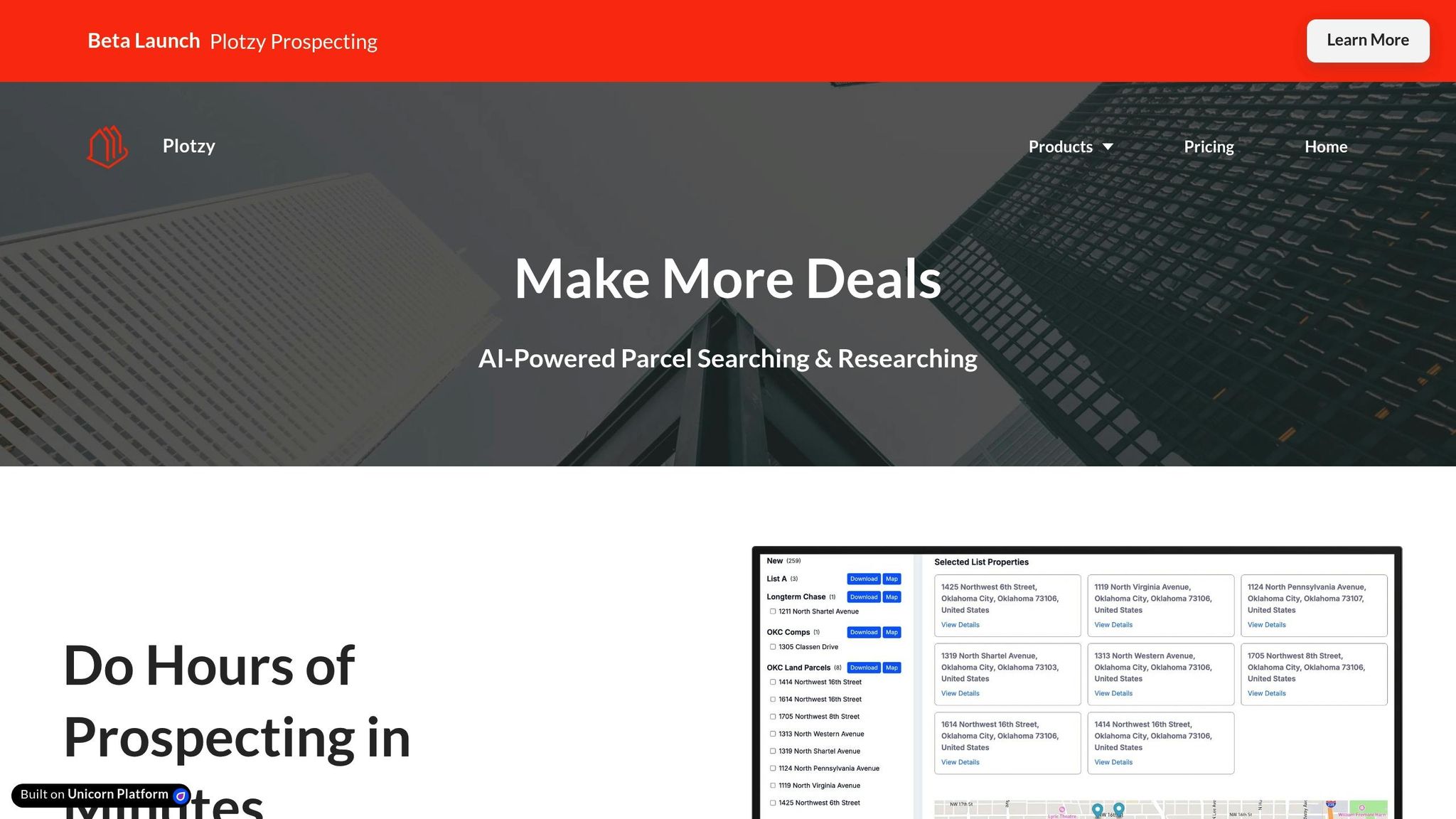Want to know if a property fits your business needs? Zoning laws dictate what you can build or operate in specific areas. Here’s a quick guide to understanding zoning and using tools like Plotzy to simplify the process:
- Zoning Basics: Zoning laws regulate land use, building size, parking, and safety standards.
- Zoning Categories: Common zones include C1 (local retail), C2 (general retail), C3 (waterfront), and more. Each allows specific uses, like dry cleaners in C1 or docks in C3.
- AI Tools for Zoning: Platforms like Plotzy analyze zoning codes in seconds, showing permitted uses, compliance requirements, and more.
- 4-Step Process with Plotzy:
- Enter property details to view zoning maps.
- Review zoning codes for allowed uses.
- Check compliance for your intended use.
- Access detailed reports for clarity.
Quick Tip: Always verify AI results with official municipal data to ensure accuracy.
Zoning Rules and Property Uses
Basics of Zoning Laws
Zoning laws in the United States regulate how land is used and buildings are constructed. Their purpose is to separate conflicting land uses, maximize property utility, and support essential infrastructure.
These laws set standards for:
- Building size and density
- Placement of structures
- Parking minimums
- Green space requirements
- Safety and accessibility
Types of Zoning Categories
Zoning classifications further detail how properties can be used. These categories shape what types of businesses and levels of development are allowed.
| Zone Type | Purpose | Common Uses |
|---|---|---|
| C1 (Local Retail) | Serve neighborhood needs | Dry cleaners, bodegas, hair salons, small clothing stores |
| C2 (General Retail) | Broader retail services | Movie theaters, funeral homes, bicycle repair shops |
| C3 (Waterfront) | Water-related activities | Docks, mooring facilities, waterfront recreation |
| C4-C6 (Mixed Commercial) | Varied commercial uses | Department stores, offices, hotels, specialized manufacturing |
| C7 (Entertainment) | Amusement-focused businesses | Ice cream parlors, restaurants, gift shops |
| C8 (General Services) | General commercial use | All commercial and general services |
The New York City Department of City Planning highlights the role of these distinctions:
"C1 zoning districts are intended to serve local shopping needs and maintain the highest level of retail continuity."
Zoning regulations also address:
- Building height limits
- Distance from street boundaries
- Accessibility standards
- Safety protocols
- Parking requirements
These rules ensure developments align with local community needs, maintain safety, and are compatible with surrounding areas.
How Do Zoning Laws Affect Property Use in New York ...
Using AI to Check Property Zoning
AI is changing the way real estate professionals verify property zoning details. Instead of combing through municipal databases and deciphering zoning codes manually, AI-powered tools now handle this process in seconds. These tools streamline research and complement the zoning frameworks discussed earlier.
How AI Processes Zoning Codes
AI tools simplify zoning research by breaking down dense legal jargon into structured, easy-to-navigate data. For example, they can quickly pinpoint permitted uses in zoning codes, helping professionals determine if a property's intended purpose aligns with local rules.
Plotzy's Zoning Search Tools

Plotzy takes AI's zoning capabilities a step further, offering tools designed to make zoning research faster and more accessible. Here's a closer look at Plotzy's features:
| Feature | Description | Benefit |
|---|---|---|
| Permitted Use Filter | Search properties by allowed uses | Quickly find parcels that meet your needs |
| Instant Zoning Q&A | AI-generated answers to zoning questions | Get clear, fast answers to complex regulations |
| Municipal Resources | Access local zoning documents directly | Confirm compliance with ease |
| Property Reports | Detailed zoning analysis | Make confident, well-informed decisions |
"Plotzy's AI technology provides zoning answers in seconds, allowing users to quickly rule in or out a property based on permitted uses", says Nathan Robinson, Co-Founder & CEO of Plotzy.
Plotzy's tools help users make quick, informed decisions about zoning. During its beta release, the Basic plan costs $65 per user and includes features like property data access, parcel boundaries, permitted use filtering, municipal documents, and instant zoning Q&A. For $200 per month, the Pro plan offers additional benefits like custom shapefiles and enhanced search options for deeper analysis.
sbb-itb-11d231f
4 Steps to Check Permitted Use in Plotzy
Plotzy's AI tools make it simple to check what a property can be used for. Here’s how you can do it in four easy steps.
Finding Zoning Information
Start by entering the property address or parcel number into Plotzy. You’ll instantly see a color-coded zoning map. Click on the parcel to bring up key zoning and property details.
The property card includes:
- Zoning classification
- Property size and dimensions
- Parcel ID
- Last sale date and price
- Current ownership details
Reading Zoning Codes
Plotzy simplifies zoning regulations, breaking them into easy-to-understand categories:
- Primary Uses: Activities allowed without extra permits
- Conditional Uses: Activities needing special approval
- Development Standards: Rules about building height, setbacks, and lot coverage
- Parking Requirements: Minimum parking spaces for different uses
For example, if you're looking at a C-2 (Commercial) property, Plotzy will show you that uses like retail stores, restaurants, and offices are typically allowed, along with any specific requirements.
Once you understand the zoning, you can move on to check compliance.
Checking Property Compliance
Plotzy’s compliance checker helps you confirm if your planned use meets zoning rules. Here’s how it works:
- Select your intended use.
- Enter your project details.
- Review the compliance report.
The report will tell you:
- If your use is allowed
- Whether permits or variances are needed
- Conditions you’ll need to meet
- Any restrictions or limitations
It also provides direct links to official municipal documents for verification.
For more detailed zoning reports and advanced filtering options, consider upgrading to the Pro plan.
Tips for Accurate Zoning Research
AI tools make zoning research easier, but following best practices ensures you get reliable and accurate results.
Verify AI Results
Always double-check AI-generated zoning data with official sources to ensure accuracy:
- Compare with municipal databases to confirm zoning classifications.
- Check recent regulation updates to account for any changes.
- Cross-reference property cards, tax records, and zoning maps for additional verification.
Keep a record of your sources and note any discrepancies for future reference. If you're dealing with properties that have multiple layers of regulations, refer to the next section for handling those cases.
Handle Complex Zoning Cases
For more complicated zoning situations, follow these steps to verify and document everything properly:
- Review special conditions and permits that may apply to the property.
- Evaluate how zoning impacts property use and whether any restrictions exist.
- Document compliance requirements to ensure you're meeting all regulations.
Here’s how to approach specific types of complex zoning cases:
1. Overlay Districts
Overlay districts come with added regulations. Identify these districts, review their specific rules, and note any conditional use requirements that might affect the property.
2. Split Zoning
When a property falls under two or more zones, identify the boundaries, calculate the land percentages for each zone, and understand how this division impacts potential uses.
3. Non-Conforming Uses
For properties with uses that don’t align with current zoning laws, check for grandfather clauses, verify existing permits, and ensure you’re aware of expiration dates or other limitations.
Plotzy Pro simplifies managing these complex cases by offering tools like:
- Detailed zoning reports for a clear overview.
- Access to historical property data.
- Custom filters for specific requirements.
- Easy-to-export documentation for compliance tracking.
These features make it easier to stay organized and ensure zoning compliance for even the most challenging cases.
Conclusion
Researching permitted property use doesn’t have to take up all your time. Tools like Plotzy, powered by AI, can simplify zoning research and help you make decisions faster.
With features like instant zoning answers, curated property lists, and in-depth compliance reports, Plotzy helps save time, lower risks, and support data-driven decision-making.
This platform gives commercial real estate professionals quick and trustworthy insights into property use. Having the right tools can make navigating zoning rules much more manageable.
Thorough zoning research is the backbone of every successful real estate transaction. By combining AI tools with proper verification, you can make informed decisions, navigate zoning rules smoothly, and identify the best properties for your needs. Using these strategies and tools, you can strengthen your position in the commercial real estate market.
FAQs
How does Plotzy ensure its AI-generated zoning data is accurate and up-to-date?
Plotzy ensures the accuracy and reliability of its AI-generated zoning data by sourcing information directly from trusted and regularly updated municipal and government databases. The platform uses advanced algorithms to interpret zoning regulations and applies rigorous updates to maintain compliance with the latest changes.
By leveraging these authoritative sources, Plotzy provides users with accurate, actionable insights to confidently assess permitted property uses and make informed decisions for site selection or development.
What should I do if a property has multiple zoning classifications or complex regulations?
If a property is subject to multiple zoning classifications or has intricate regulations, start by reviewing the zoning details carefully. Pay close attention to allowed uses, setback requirements, parking rules, and density limits. These factors can significantly impact the property's development potential.
Document any specific restrictions or additional approvals required by the local municipality. This will help you determine whether the property aligns with your goals and ensure compliance with all regulations before proceeding with your project.
How does Plotzy's AI tool make zoning research faster and more accurate compared to traditional methods?
Plotzy's AI-powered tool significantly improves both the speed and accuracy of zoning research compared to traditional manual methods. While traditional zoning analysis can take weeks to complete, Plotzy streamlines the process, delivering results in as little as two business days.
By automating the analysis of zoning data and property records from multiple sources, Plotzy eliminates the need for time-consuming manual data entry and cross-checking. This not only accelerates workflows but also minimizes the risk of human error, making it a more reliable solution for zoning research and property use assessments.


